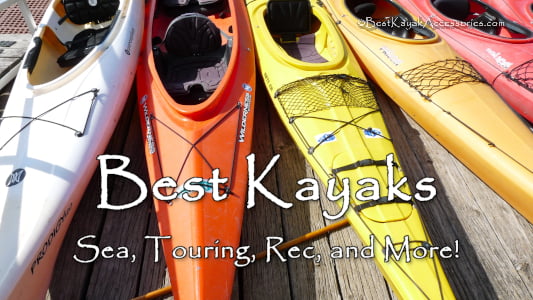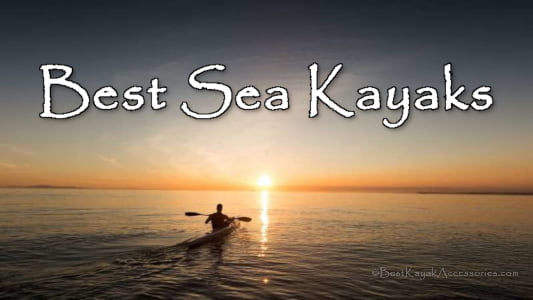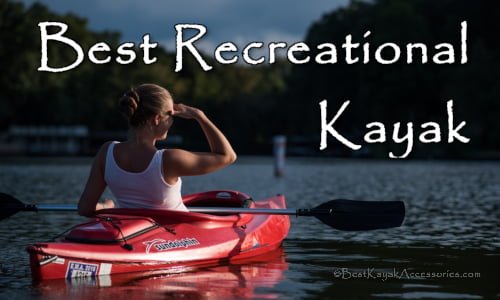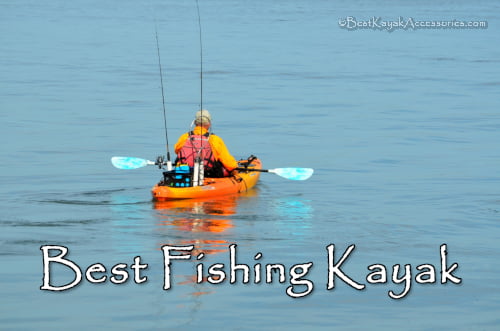Shop Now for the Best Kayaks
What should I consider when choosing the BEST kayaks?
When looking at the best kayaks, there isn’t one that’s best for every person. There are a number of things to consider, like:
- What are you going to use it for?
- Where are you going to be kayaking?
- How are you going to store the kayak?
- How do you plan to transport the kayak?
These are a few things to consider. Let’s take a look at some of the categories of kayaks, which should help you narrow it down some.
What is a Recreational Kayak?
Use: Flatwater, slow rivers.
These are the basic kayaks that you see at most department and sporting good stores. Recreational kayaks are usually short (10-12′ L) and wide (27-30″ W), which give them good stability. These features, make many of them track poorly (which means to go straight). Without a skeg or rudder, you may fight to keep this type of kayak going straight. Recreational kayaks are good for flatwater and downstream paddling. Going upstream, waves, or currents are not an ideal situation for these types. Large cockpit openings can let water in easier and most don’t have bulkheads, which can make the boat hard to recover if it gets flooded.
What is a Touring Kayak?
Use: Flatwater, slow to medium rivers, and small waves.
Touring Kayaks are a versatile kayak that is usually the next step up from a rec kayak. It is usually longer (13-16′ L) and narrower (23-26″ W). This makes a touring kayak faster and it tracks straighter than the recreational kayak. The trade-off is that it makes the kayak harder to turn. However, some good paddling technique and edging can help with this limitation. You can also add a rudder to many touring kayaks. Touring kayaks usually offer a lot of storage for your gear. Gear can be placed dry hatches that are separated from the cockpit by bulkheads to keep the boat afloat if you capsize. Many touring kayaks have front and rear hatches.
What is a Sea Kayak?
Use: Flatwater, slow to medium rivers, open water with unpredictable conditions.
Sea Kayaks are also very versatile. Some people use the term Touring and Sea kayaks interchangeably, but to us and many others, the sea kayak is usually a bit longer (16-20′ L) and even narrower than a touring kayak. The cockpits are usually tighter fitting, which reduces the chance of spray skirts coming loose due to waves coming over the side of the boat. Sea Kayaks have a large amount of storage in front and rear dry hatches. They also usually have a rudder or skeg to help with tracking in rough conditions. These boats are usually fast, due to their long, narrow build. However, they are more difficult to turn than a touring a recreational kayak. You will need more advanced skills for this type of kayak, like bow rudder, edging, etc, especially if you are going to use the boat in rivers and less open water areas.
Inflatable Kayaks:
Use: Flatwater, slow rivers
Most Inflatable kayak uses are going to be similar to recreational kayaks. Inflatables are easy to transport and usually pretty budget friendly. The downside is that they can spring a leak, aren’t as durable, and take more effort to paddle. Some inflatable kayaks have multiple air compartments, so if a leak occurs, you will still have flotation from other air chambers. Most inflatables are pretty wide(30″+). Some have protective coverings to help protect the kayak against wear and punctures while on the water.
Use: Can vary
Fishing kayaks can be sit on top or sit inside, depending on your preference. We find that in most coastal areas like we are, fishermen prefer sit on top fishing kayaks. These are very stable, and will not hold water if they do tip or catch a wave. They will have many fishing specific attachments and options to hold gear and make the kayak an asset in your fishing adventure.
Sit On Top Kayaks:
Use: Can vary
Sit on top (SOT) kayaks can be regular use or fishing specific. We will limit this section to general use, as the Fishing Kayaks page will include fishing specific SOT. SOT kayaks are self-bailing, so water will drain out of them. They are easy to get in and out of, and are usually very stable. Depending on their size, these may be faster than a basic recreational kayak, but usually aren’t as fast or have as much gear storage as a touring/sea kayak.

Best Kayaks Overall
Best Sea Kayaks

If you are going on longer overnight trips, open water, choppy seas, etc., you want to make sure you have the best sea kayaks for your trip. There are a lot of options for these, so we are going to consider kayaks over 16 feet for this category. If you are looking for a shorter boat, then check out our best touring kayaks and best recreational kayaks.
Rating sea kayaks is very subjective, since the “best” will depend on what you are looking for and what you use the kayak for. So, we rank these based on their versatility, customer ratings, and features.
Things to Consider:
Some important things to consider when deciding on the best sea kayaks for yourself:
- Material: Will it be durable enough for where you plan to paddle?
- Weight: Can you move it around, load it, etc?
- Max capacity: This is the weight of the boat, paddler, and all gear. Can it carry what you want it to?
- Bulkheads: These keep hatch areas water tight, and allow the kayak to be rescued easier in the event you capsize and then have to pump/bail water from the kayak.
- Hatches: These store your gear in dry areas below deck. The number and location of hatches can improve your accessability to gear on your trips.
Our top 3 are hard to separate honestly. Since each has some pros and each has some cons, they are pretty close. These are very versatile, but also relatively affordable with some great features. The ones further down are either significantly more expensive or have some compromises that may not appeal to most users. We have made some notes on these, so take a look.
Do you agree with our list? Did we leave something off? Leave a comment below to let us know!
Once you’ve found your best sea kayaks, don’t forget to review the best paddles for kayak.
2. Old Town Looksha 17 Kayak (17.3′) – Shop Now
- Material: Polyethylene
- Dimensions: 208″ L x 23.75″ W
- Weight: 68 lbs
- Max Capacity: 375 lbs
- Bulkheads: 2
- Hatches: 2
- Includes rudder
5. Current Designs Solstice GTS (17.6′) – Info
- Material: Fiberglass or Kevlar
- Dimensions: 211″ L x 22″ W
- Weight: Fiberglass: 52 lbs / Kevlar: 48 lbs
- Max Capacity: 400 lbs
- Bulkheads: 2
- Hatches: 2
- Includes rudder
6. Eddyline Fathom Kayak (16.5′) – Shop Now
- Material: Carbonlite
- Dimensions: 198″ L x 22″ W
- Weight: 50 lbs
- Max Capacity: 340 lbs
- Bulkheads: 2
- Hatches: 3
- Includes skeg
7. Necky Chatham 18 Kayak (17.75′) – Shop Now
- Material: Fiberglass
- Dimensions: 213″ L x 20″ W
- Weight: 53 lbs
- Max Capacity: 325-350 lbs
- Bulkheads: 2
- Hatches: 3
- Includes skeg
8. Riot Kayaks Brittany 16.5 Kayak (16.5′) – Shop Now
- Material: Polyethylene
- Dimensions: 198″ L x 21.75″ W
- Weight: 51 lbs
- Max Capacity: 350 lbs
- Bulkheads: 3
- Hatches: 3
- Includes skeg and rudder
For sea kayak info and history, see the Wiki.
Best Recreational Kayak

It’s hard to define the best recreational kayak. As with our other categories, it depends how you are planning to use the kayak. In this list, we will look at the best all around sit-in kayaks 13′ and under. You may be surprised at these, as they aren’t necessarily beginner kayaks. We try to recommend kayaks that will be a good option for a long period of time, and you won’t feel like you have to upgrade right away.
For the best kayak for beginners, review that page and make sure to read the info to consider all options. Also, check out sit-on-top kayaks for more recreational options.
Recreational kayaks are good for flatwater and slow rivers. They are usually shorter and wider than a touring kayak or sea kayak. This tends to make them more stable, but they usually don’t track as well. Tracking is where the kayak will go straight ahead as you paddle. For this reason, we usually recommend the longer recreational kayaks or one with a tracking system like a skeg.
Note: For the best recreational kayaks that don’t have front bulkheads or flotation, you should consider getting a float bag (Shop Now). This keeps the front of the boat from sinking, so you can rescue the kayak if you capsize or get flooded.
5. Perception Expression 11.5 Kayak – Shop Now
- Material: Polyethylene
- Dimensions: 139″ L x 25.75″ W
- Weight: 44 lbs
- Max Capacity: 250 lbs
- Bulkheads: 1 rear, no front flotation
- Hatches: 2
- Includes deployable skeg
- Also available in 14.5′ and 15.0′
6. Wilderness Systems Aspire 105 Rec Kayak – Shop Now
- Material: Polyethylene
- Dimensions: 130″ L x 29″ W
- Weight: 48 lbs
- Max Capacity: 450 lbs
- Bulkheads: 1 rear, styrofoam front flotation
- Hatches: 1
- Includes skeg
9. Sun Dolphin Aruba SS 12 – Shop Now
- Material: Polyethylene
- Dimensions: 143.5″ L x 30″ W
- Weight: 47 lbs
- Max Capacity: 395 lbs
- Bulkheads: 1 rear, no front flotation
- Hatches: 3
Best Fishing Kayak

The best fishing kayak may depend on your preferences, but there are a lot of options to consider when buying your kayak. How do you want to get to your fishing spot – paddle or pedal? How many hatches and wells do you need? What weight capacity is required (your weight, gear, bait, and fish)?
Many people enjoy the pedal drive kayaks. Just remember they do need a little more water clearance, even with the motors/fins up, and they aren’t as maneuverable in tight spaces – a paddle is still handy for these situations. Below, we have given some of the best options for both paddle and pedal drive fishing kayaks. We start with the Hobie Mirage Pro Angler. While it is expensive, it is one that many enjoy and has one of the most reliable pedal systems available. If you can afford the investment, that’s our top pick, but there are so many other great options.
Did we leave one off? Do you have experience with any of these? Leave your feedback in the comments below!
1. Hobie Mirage Pro Angler 14 Kayak – Camo Package – Shop Now
- Propulsion – Pedals – Mirage Drive 180 w/ turbo fins
- 600 lb capacity
- 13′ 8 ” L, 38″ W, 144.5 lbs unloaded
- 3 hatches
- 2 vertical rod holders, 6 horizontal rod holders
- Paddle included
- Retractable rudder
- Other sizes, colors, and configurations of Hobie Mirage kayaks: Shop Now
2. Ocean Kayak Prowler Big Game II Angler Kayak – Shop Now
- Propulsion – Paddle
- 600 lb capacity
- 12′ 9″ L, 34″ W, 70 lbs unloaded
- Front hatch and mod pod center hatch
- 2 vertical rod holders, 6 accessory mounting plates
- Optional rudder system
6. Old Town Topwater 106 PDL Angler Fishing Kayak – Shop Now
- Propulsion – Pedal or paddle
- 450 lb capacity
- 10′ 6″ L, 36″ W, 76.5 lbs unloaded
- 1 hatch (front)
- 3 rod holders, 2 accessory tracks
- Rudder included
7. Advanced Elements Straitedge Angler Kayak – Shop Now
- Inflatable kayak w/ large number of positive reviews
- 400 lb capacity
- 10′ 6″ L, 38.5″ W, 45 lbs unloaded
- 2 rod holders
- 2 accessory frames, duffle bag, and repair kit included
- Removable fin
























